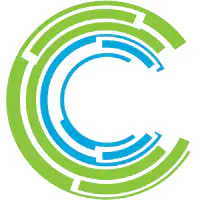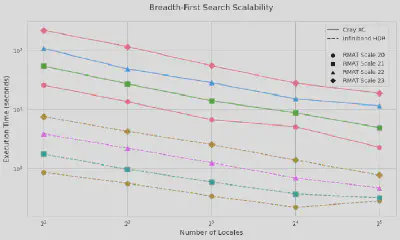7 Questions for David Bader: Graph Analytics at Scale with Arkouda and Chapel

By: Engin Kayraklioglu, Brad Chamberlain
In this installment of our 7 Questions for Chapel Users series, we welcome David Bader, a Distinguished Professor in the Ying Wu College of Computing at the New Jersey Institute of Technology (NJIT). With a deep focus on high-performance computing and data science, David has consistently driven innovation in solving some of the most complex and large-scale computational problems. Read on to dive into his journey with Chapel, his current projects, and how tools like Arkouda and Arachne are accelerating data science at scale.
1. Who are you?
I am David Bader, currently serving as the Director of the Institute for Data Science at NJIT. My expertise lies in scalable data analytics and parallel computing, where I focus on addressing large-scale data challenges that impact our daily lives, such as social network analysis, cybersecurity, and bioinformatics. I have led the team that has developed Arachne, an Arkouda package that extends its interactive data exploration capabilities to also handle complex graph analytics through scalable algorithms. Over the years, I have collaborated with teams across academia, government, and industry to develop solutions that push the boundaries of computing.
2. What do you do? What problems are you trying to solve?
My work revolves around developing efficient algorithms and frameworks for processing and analyzing massive datasets. The challenges I tackle often have broad societal impact, such as improving our understanding of disease pathways, detecting cyber threats in real time, and optimizing infrastructure networks. Many of these problems require harnessing the power of modern supercomputers and parallel architectures to deliver solutions at unprecedented scales and speeds.
“Arachne helps us execute complex graph analytics on dynamic datasets with extreme scalability and performance.”
With frameworks like Arkouda, we are able to provide data scientists the ability to work interactively on large datasets with the simplicity of Python, but at the performance levels of HPC systems. Similarly, Arachne helps us execute complex graph analytics on dynamic datasets with extreme scalability and performance. These tools are essential for translating cutting-edge research into real-world applications.
3. How does Chapel help you with these problems?
Chapel provides a unique advantage by allowing its users to express parallelism and locality in a more intuitive manner compared to traditional parallel programming languages like MPI or OpenMP. It offers a modern programming model that is both high-level and highly performant, making it easier to develop and maintain complex data analytics applications. We run Chapel on a variety of systems, from local clusters to national-scale supercomputers, and its flexibility and scalability have been invaluable in bridging the gap between research prototypes and real-world deployments.
“Students in my group, without prior experience in parallel programming, were able to write and implement scalable graph algorithms in Chapel within just a few weeks.”
Arkouda’s Chapel-powered backend supports scalable and interactive processing of dataframes with millions of elements, giving data scientists the power to analyze data interactively without worrying about the complexity of parallel processing. For Arachne, Chapel allows us to efficiently manage large graph structures and parallelize analytics workloads, which is crucial when working with massive social networks or biological interaction networks.

In addition to Chapel’s strengths in parallelism and locality, it has proven to be highly accessible for new users. For instance, students in my group, without prior experience in parallel programming, were able to write and implement scalable graph algorithms in Chapel within just a few weeks. This intuitive learning curve allowed them to quickly contribute to Arachne’s graph analytics, demonstrating how Chapel can be leveraged to rapidly develop solutions even by those new to parallel programming and HPC.
4. What initially drew you to Chapel?
I first learned about Chapel decades ago as an investigator in the DARPA High Productivity Computing Systems (HPCS) program. At the time, I was drawn to its potential for transforming productivity in parallel computing, making it feasible to tackle challenging problems at scale. What stood out to me was how Chapel abstracted away the low-level details of parallel programming while retaining the performance characteristics necessary for high-end computing. Chapel’s promise to improve productivity and facilitate high-performance application development made it a compelling choice for our research projects.
5. What are your biggest successes that Chapel has helped achieve?
Using Chapel, we’ve been able to implement parallel algorithms for graph analytics that scale efficiently across thousands of cores. One of Chapel’s most impactful successes has been the development of Arkouda, a tool that allows data scientists to manipulate large datasets interactively and perform exploratory data analysis at unprecedented scales. This wouldn’t have been possible without Chapel’s robust parallel programming capabilities.
“With Arachne, we’ve successfully demonstrated how complex graph problems can be tackled using Chapel, providing solutions that are not only scalable but also highly efficient in real-world scenarios.”
With Arachne, the Arkouda package we design and develop here at NJIT, we’ve successfully demonstrated how complex graph problems can be tackled using Chapel to process dynamic and irregular data structures, providing solutions that are not only scalable but also highly efficient in real-world scenarios. These tools have helped us advance the field of data science by providing new avenues for scalable data processing and analytics.

6. If you could improve Chapel with a finger snap, what would you do?
I’d focus on enhancing Chapel’s integration with existing machine learning and data science libraries, particularly those in Python. Seamlessly combining Chapel’s parallelism with the extensive ecosystem of data science tools would significantly broaden its applicability and reduce the friction for users transitioning between traditional and parallel environments. For frameworks like Arkouda and Arachne, tighter integration with Python would make it even easier for data scientists to leverage the power of Chapel in their existing workflows.
7. Anything else you’d like people to know?
“I’m excited about the growing intersections between data science, graph analytics, and real-world applications. And I believe that languages like Chapel will play a pivotal role in shaping the future of computational research.”
I encourage researchers and developers interested in high-performance data analytics to explore Chapel. Its modern approach to parallel computing makes it a valuable tool for tackling today’s data challenges. As for my own work, I’m excited about the growing intersections between data science, graph analytics, and real-world applications. And I believe that languages like Chapel will play a pivotal role in shaping the future of computational research.
Frameworks like Arkouda and Arachne demonstrate how Chapel can serve as a powerful foundation for building scalable, high-performance tools. Whether you’re dealing with massive dataframes or complex graph structures, Chapel’s expressive parallelism and scalability can be a game-changer.
We’d like to thank David Bader for participating in the 7 Questions for Chapel Users series. To learn more about David’s team’s work, make sure to check out his website. David’s work showcases how powerful and flexible modern parallel programming languages like Chapel can be for addressing large-scale data challenges. With tools like Arkouda and Arachne, he continues to push the boundaries of data science and parallel computing. We look forward to seeing how his work evolves and inspires the next generation of computational breakthroughs!
If you have any questions for David, or comments, please direct them to the 7 Questions for Chapel Users thread on Discourse.